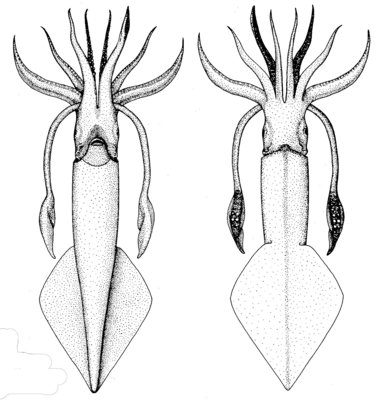Doryteuthis (Amerigo) pealeii
Longfin inshore squid
Michael Vecchione and Richard E. YoungIntroduction
This is the common inshore squid of the northeastern U.S. Maximum length: 47 cm ML (male); males grow larger than females; sizes in western central Atlantic are considerably smaller than in northern waters - males: 30 cm maximum, less than 20 cm average; females: less than 13 cm ML.
Characteristics
- Arms
- Left ventral arm of mature males hectocotylized by modification of the distal third to fourth of arm, but the modification does not extend to arm tip; fewer than 12 of the suckers in dorsal row usually smaller than half the size of their counterparts in the ventral row; bases or pedicels of some of the modified suckers rounded, narrowly triangular.
- Head
- Eyes
- Eyes not unusually large, diameter of externally visible eyeball 8 to 18% mantle length, and diameter of dissected lens 2 to 6% mantle length.
- Beaks: Descriptions can be found here: Lower beak; upper beak.
- Eyes
- Mantle
- Mantle long, moderately slender, cylindrical, the posterior end bluntly pointed.
- Fins
- Fins rhomboid, their sides nearly straight.
- Gladius
- Gladius long, rather wide, feather-shaped.
- Ratio of greatest width of vane of gladius to greatest width of rachis 2.7 to 3.7 in females, 2.4 to 2.9 in males.
- edge of vane curved (sometimes straight in males), thin, rarely ribbed.
Geographic Distribution
Western Atlantic continental shelf and upper slope waters from Nova Scotia to Venezuela, including the Gulf of Mexico and the Caribbean Sea. Not occurring around islands, except as rare strays at islands close to continental shelf or slope.
Habitat and Biology
North of Cape Hatteras there is a summer, inshore-northerly spawning migration to shallow coastal and shelf waters, followed by an offshore-southerly retreat in fall and winter to continental slope waters; restricted in summer to surface and shallow water, but from 28 - 366 m depth in winter (peak concentrations at 100 - 193 m); adults are found on the bottom during day but leave the bottom at night, dispersing into the water column, and may appear at the surface (in summer or warm water).
Optimum temperatures 10 - 14 C, minimum 8 C.
North of Cape Hatteras, spawning occurs in coastal waters and bays during late spring and summer and offshore near the shelf break during winter and early spring. Eggs laid in gelatinous finger-like strands, many of which are attached together in large masses (“sea mops”) to a solid substrate (rock, shells, man-made objects) at depths from a few to 250 m; planktonic paralarvae and juveniles are abundant in surface waters.
Food includes crustaceans (e.g. euphausids), fishes and squids.
Other Names for Doryteuthis (Amerigo) pealeii
- Vernacular Names: En: Longfin inshore squid, Fr: Calmar totam, Sp: Calamar comun.
Title Illustrations

| Scientific Name | Doryteuthis (Amerigo) pealeii |
|---|---|
| Acknowledgements | Vecchione, M., C.F.E. Roper, and M.J. Sweeney. 1989. Marine flora and fauna of the eastern United States. Mollusca: Cephalopoda. NOAA Tech. Rep. NMFS 73:1-23. |
| Scientific Name | Doryteuthis pealeii |
|---|---|
| Specimen Condition | Live Specimen |
| View | Dorsal |
| Image Use |
 This media file is licensed under the Creative Commons Attribution-NonCommercial License - Version 3.0. This media file is licensed under the Creative Commons Attribution-NonCommercial License - Version 3.0.
|
| Copyright |
©

|
About This Page

National Museum of Natural History, Washington, D. C. , USA

University of Hawaii, Honolulu, HI, USA
Correspondence regarding this page should be directed to Michael Vecchione at
Page copyright © 2010
 Page: Tree of Life
Doryteuthis (Amerigo) pealeii . Longfin inshore squid.
Authored by
Michael Vecchione and Richard E. Young.
The TEXT of this page is licensed under the
Creative Commons Attribution-NonCommercial License - Version 3.0. Note that images and other media
featured on this page are each governed by their own license, and they may or may not be available
for reuse. Click on an image or a media link to access the media data window, which provides the
relevant licensing information. For the general terms and conditions of ToL material reuse and
redistribution, please see the Tree of Life Copyright
Policies.
Page: Tree of Life
Doryteuthis (Amerigo) pealeii . Longfin inshore squid.
Authored by
Michael Vecchione and Richard E. Young.
The TEXT of this page is licensed under the
Creative Commons Attribution-NonCommercial License - Version 3.0. Note that images and other media
featured on this page are each governed by their own license, and they may or may not be available
for reuse. Click on an image or a media link to access the media data window, which provides the
relevant licensing information. For the general terms and conditions of ToL material reuse and
redistribution, please see the Tree of Life Copyright
Policies.
- First online 02 September 2010
- Content changed 02 September 2010
Citing this page:
Vecchione, Michael and Richard E. Young. 2010. Doryteuthis (Amerigo) pealeii . Longfin inshore squid. Version 02 September 2010 (under construction). http://tolweb.org/Doryteuthis_%28Amerigo%29_pealeii/52727/2010.09.02 in The Tree of Life Web Project, http://tolweb.org/










 Go to quick links
Go to quick search
Go to navigation for this section of the ToL site
Go to detailed links for the ToL site
Go to quick links
Go to quick search
Go to navigation for this section of the ToL site
Go to detailed links for the ToL site